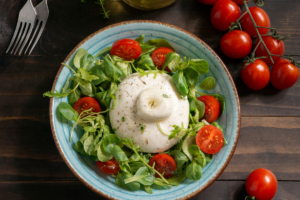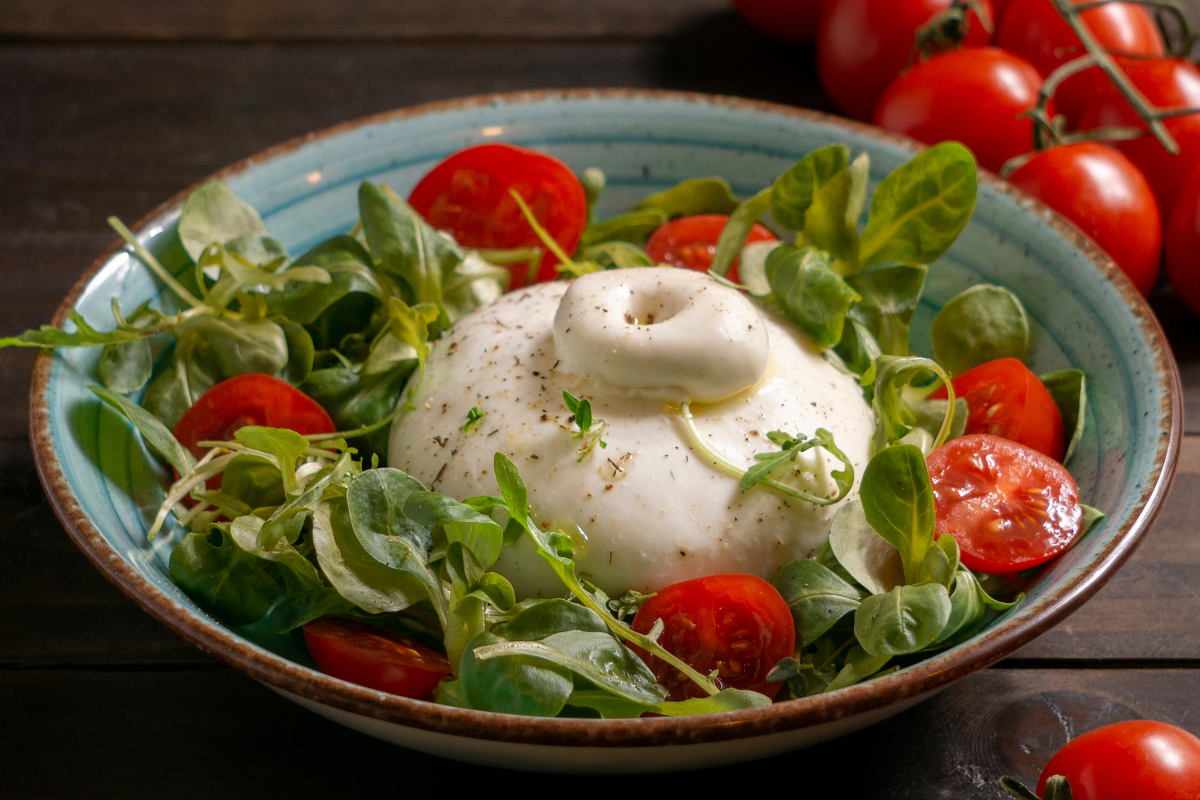Burrata cheese is a luxurious Italian cheese that has taken the culinary world by storm in recent years. Its creamy, decadent interior and smooth mozzarella shell make it a favorite for cheese lovers and food enthusiasts alike. But what exactly is burrata cheese, and why has it become so popular in kitchens across the globe?
This comprehensive guide will dive deep into what makes burrata so special, how it’s made, the best ways to serve it, its nutritional benefits, and more. By the end of this article, you’ll understand why this Italian delicacy should be on your next grocery list.
What Is Burrata Cheese ?
Burrata is essentially a type of Italian cheese that originally came from the Puglia region of Italy. Notably, it consists of two distinct parts: an outer shell made from mozzarella, while the inside features a creamy, buttery interior filled with stracciatella and fresh cream. This combination of textures and flavors creates a cheese that is both rich and delicate.
The name “burrata” comes from the Italian word burro, meaning butter, which accurately describes the cheese’s creamy, melt-in-your-mouth quality. Unlike mozzarella, which has a uniform texture, burrata surprises you with a luscious, liquid center that oozes out when cut.
The Origins of Burrata Cheese.
The history of burrata dates back to the early 20th century, when it was first made by cheesemakers in the Puglia region. Originally, burrata was a way to use up leftover mozzarella curds. Cheesemakers would fill a pouch of fresh mozzarella with curds and cream, creating a cheese that was both economical and delicious. Over time, burrata evolved into a delicacy revered for its artisanal craftsmanship and unique flavor profile.
Difference Between Burrata and Mozzarella.
At first glance, burrata and mozzarella may seem similar—they both come from cow or buffalo milk and share a soft, delicate texture. However, there are key differences between the two:
- Mozzarella: A semi-soft cheese with a uniform, elastic texture. It’s typically served sliced or melted.
- Burrata: A mozzarella shell filled with a creamy interior. The outer layer is firmer, while the inside is rich, smooth, and spreadable.
In short, mozzarella offers a simple, uniform experience, while burrata delivers a creamy, more indulgent flavor. To fully appreciate the difference, try both side by side!
How Is Burrata Cheese Made ?
Making burrata is a labor of love, involving both traditional techniques and careful craftsmanship. Here’s a step-by-step breakdown of the process:
- Curdling the Milk: Fresh cow or buffalo milk is heated and combined with rennet to form curds. This is the first step in making mozzarella and burrata alike.
- Forming the Mozzarella: Once the curds have formed, they are kneaded and stretched until they become smooth and elastic. This mozzarella is then shaped into a small pouch.
- Creating the Filling: The leftover curds are mixed with cream to form stracciatella, the luscious filling that makes burrata so special.
- Assembling the Burrata: The stracciatella is carefully spooned into the mozzarella pouch, and the top is sealed to keep the filling inside. The burrata is then immersed in brine, which helps preserve its texture and flavor.
The result is a cheese with a firm outer shell and a creamy, liquid center that bursts with flavor when cut open.
How to Serve Burrata Cheese: Elevate Any Meal ?

One of the reasons burrata has become so beloved is its versatility. Whether you’re looking for an elegant appetizer or a creamy addition to your salad, burrata can take your dish to the next level.
Best Ways to Serve Burrata
Burrata is best enjoyed fresh and at room temperature. Here are some delicious ways to serve it:
- Classic Caprese Salad: Replace mozzarella with burrata for an even creamier take on this classic Italian salad. Layer burrata with fresh tomatoes, basil, and a drizzle of olive oil for a simple yet indulgent dish.
- On Grilled Bread: Top grilled slices of sourdough or baguette with burrata, a sprinkle of sea salt, and a drizzle of balsamic glaze. This makes for an easy yet sophisticated appetizer.
- On Pizza: Add burrata to your pizza after baking. The heat from the crust will soften the burrata, creating a luxurious, creamy topping without losing its distinct texture.
- With Fresh Fruits: Pair burrata with fruits like figs, peaches, or strawberries. The sweetness of the fruit complements the creaminess of the cheese perfectly.
- As a Standalone Dish: Serve burrata simply with olive oil, fresh herbs, and crusty bread. Let the cheese be the star of the plate!
Pairing Burrata with Other Foods
Burrata pairs well with a wide variety of flavors, from sweet to savory. Some of the best pairings include:
- Cured Meats: Prosciutto, salami, or pancetta provide a salty contrast to the creaminess of burrata.
- Fresh Vegetables: Burrata complements roasted or grilled vegetables like zucchini, eggplant, or bell peppers.
- Nuts and Seeds: Toasted almonds or pine nuts add a delightful crunch to a dish featuring burrata.
- Balsamic Vinegar: A drizzle of aged balsamic vinegar enhances the richness of burrata, adding a tangy, slightly sweet note.
For more unique pairing ideas, you can explore dishes that incorporate a wide variety of ingredients, such as sourdough French toast with burrata or even combining it with salads that include rich proteins like chicken or beef.
Nutritional Profile: Is Burrata Cheese Healthy ?
While burrata is undeniably delicious, it’s also important to consider its nutritional profile. Like most cheeses, burrata is rich in fat and calories. Here’s a quick look at its nutritional breakdown:
- Calories: A typical 100-gram serving of burrata contains around 300 calories.
- Fat: Burrata is high in fat, with about 25 grams of fat per 100-gram serving, much of it coming from saturated fat.
- Protein: It provides about 12 grams of protein per serving, making it a good source of this essential nutrient.
- Calcium: Burrata is rich in calcium, offering about 15% of your daily recommended intake per serving.
While burrata can be part of a healthy diet when eaten in moderation, its high-fat content means it’s best enjoyed as an occasional treat rather than a daily staple.
Burrata Cheese: A Symbol of Italian Culinary Craftsmanship
Burrata is more than just a cheese—it’s a symbol of Italian culinary craftsmanship and the rich history of traditional cheesemaking in the Puglia region. Since its creation in the early 20th century, burrata has evolved from a practical solution to using leftover curds to a beloved gourmet delicacy enjoyed worldwide.
In Italy, burrata is often made by hand in small batches, using traditional techniques that have been passed down through generations. This artisanal approach is part of what makes burrata so special , it’s a product of both skill and dedication.
Burrata Around the World
While burrata was once a hidden gem known only in Italy, it has since gained popularity around the world. Nowadays, you can find burrata in gourmet food stores, specialty cheese shops, and even mainstream supermarkets. This widespread availability is a clear testament to the universal appeal of its creamy, rich flavor.
FAQs.
- What’s the difference between burrata and mozzarella?
While both cheeses are made from cow or buffalo milk, mozzarella is firm and elastic, while burrata has a creamy, soft interior. - How do you store burrata?
Burrata should be stored in the refrigerator, submerged in its brine. It’s best eaten within 24-48 hours of purchase for optimal freshness. - Can you freeze burrata cheese?
Freezing burrata is not recommended, as it can alter the texture of both the outer shell and the creamy filling. - Is burrata cheese high in calories?
Yes, burrata is a high-calorie cheese, with about 300 calories per 100 grams. It’s best enjoyed in moderation. - What are some good pairings for burrata?
Burrata pairs well with fresh fruits, cured meats, roasted vegetables, balsamic vinegar, and grilled bread.
Conclusion :
Burrata cheese delights with its combination of flavors and textures that no other cheese can match. Whether you’re serving it as a standalone appetizer, adding it to a pizza, or pairing it with fresh fruits and vegetables, burrata has the ability to elevate any dish.
From its humble beginnings in Italy to its current status as a global gourmet favorite, burrata continues to captivate cheese lovers with its creamy, indulgent taste. So, if you haven’t already tried burrata, now is the time to add it to your next meal it’s an experience you won’t forget.
This complete guide to burrata cheese equips you to enjoy this Italian delicacy in a variety of ways, whether you cook at home or dine at your favorite restaurant. Enjoy!

